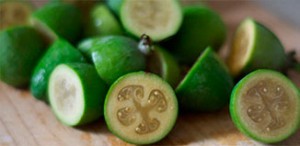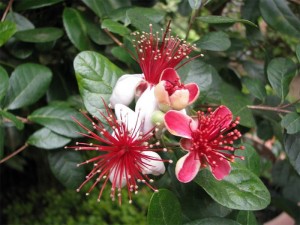 The spicy aroma and tangy taste of these green, South American natives is unbeatable, and their shape and size make them good lunch box fruit for children — manageable for small fingers in a hurry!
The spicy aroma and tangy taste of these green, South American natives is unbeatable, and their shape and size make them good lunch box fruit for children — manageable for small fingers in a hurry!
Hardy and easy to grow, the versatile plants require only a minimum of care once established, and will provide heaps of fruit from late summer through to autumn.
Feijoas will grow on most soils, providing drainage is good, although they appreciate compost, mulch, and well-aged manure. They also like a few handfuls of general garden fertiliser during the growing season, from spring through to early autumn. Fruit quality and size is affected by soil fertility, and the heavier soils produce better fruit.
Although withstanding high summer temperatures, and able to tolerate moderate salt spray, they need to be watered well during long, dry periods and when fruit is developing.
The plants are able to cope with frosts of -6degC, although fruit will suffer some damage under -5degC.
 Feijoas hardiness keep it relatively pest and disease-free, and a young tree will flower in its first two years. The flowers have fleshy petals that attract birds for pollination, but petals from well-watered trees are fleshy enough to pick and add to salads and desserts — they have a spicy, sweet flavour.
Feijoas hardiness keep it relatively pest and disease-free, and a young tree will flower in its first two years. The flowers have fleshy petals that attract birds for pollination, but petals from well-watered trees are fleshy enough to pick and add to salads and desserts — they have a spicy, sweet flavour.
Fruit will not develop in any numbers until about the tree’s fourth year, and will appear on new growth on the outside of the plant. Pruning is a simple matter of trimming the outer branches to encourage this new growth after harvest is over. It’s also best to take out low hanging or broken branches, opening the tree to let in birds and insects for pollination, wind movement and sun for fruit ripening.
Harvest when wind-fallen fruit starts to appear on the ground. When picking, select fruit that is slightly soft to the touch – feijoas will ripen a little once picked, but are best left on the tree to ripen naturally.
Trees will mature to 2–3 m in height, and approximately 1.5–2m wide, and there is a wide range of varieties to choose from. However, only one variety, ‘Unique’, is truly self-fertile, so it’s best to plant at least two feijoa bushes to ensure cross-pollination. ‘Unique’ is a vigorous plant and produces medium-sized, juicy fruit early in the season.
Some varieties, such as ‘Apollo’ and ‘Wiki Tui’, are partially self fertile and will set fruit if grown on their own, but they produce much bigger and better crops if grown in the company of others.
Like ‘Unique’, ‘Apollo’ is a vigorous grower, but fruits in mid-season — the large fruit are mild and aromatic, with a juicy, sweet flavour.
Both the compact growing ‘Wiki Tui’ , which produces extremely large fruit with a good flavour, and the milder flavoured, ‘Opal Star’, can be grown in large containers and will fruit plentifully, but must be planted in a free draining mix, given adequate fertility and watered well.

